Application of Thionocarbamates in Copper Slag Flotation
Abstract
:1. Introduction
Adsorption Mechanism of Thionocarbamates
2. Materials and Methods
2.1. Materials
2.2. Collectors
2.2.1. Sodium Isopropyl Xanthate
2.2.2. AERO MX 980
2.2.3. TC 1000
2.3. Methods
2.3.1. Chemical Composition
2.3.2. X-ray Diffraction (XRD) Analysis
2.3.3. Scanning Electron Microscopy (SEM) Analysis
2.3.4. Grinding and Flotation Tests
3. Results and Discussion
3.1. Chemical Composition
3.2. XRD Analysis
3.3. Scanning Electron Microscopy (SEM) Analysis
3.4. Flotation Tests
3.4.1. Collector Type and Dosage
3.4.2. Fineness of Grinding
3.4.3. Pulps’ pH
3.4.4. Flotation Kinetics
3.4.5. Statistical Analysis
4. Conclusions
Author Contributions
Funding
Institutional Review Board Statement
Informed Consent Statement
Data Availability Statement
Acknowledgments
Conflicts of Interest
References
- Wills, B.A.; Napier-Munn, T. Wills’ Mineral Processing Technology—An Introduction to the Practical Aspects of Ore Treatment and Mineral Recovery, 7th ed.; Elsevier Science & Technology Books; Elsevier: Amsterdam, The Netherlands, 2006. [Google Scholar]
- Bulatović, S.M. Handbook of Flotation Reagents. Chemistry. In Theory and Practice: Flotation of Sulfide Ores; Elsevier Science & Technology Books; Elsevier: Amsterdam, The Netherlands, 2007. [Google Scholar]
- Wills, B.A.; Finch, J.A. Wills’ Mineral Processing Technology—An Introduction to the Practical Aspects of Ore Treatment and Mineral Recovery, 8th ed.; Elsevier Science & Technology Books; Elsevier: Amsterdam, The Netherlands, 2016. [Google Scholar]
- Sokolović, J.; Stanojlović, R.; Andrić, L.; Štirbanović, Z.; Ćirić, N. Flotation studies of copper ore Majdanpek to enhance copper recovery and concentrate grade with different collectors. J. Min. Metall. A Min. 2019, 55, 53–65. [Google Scholar] [CrossRef]
- Dhar, P.; Thornhill, M.; Rao Kota, H. Comparison of single and mixed reagent systems for flotation of copper sulphides from Nussir ore. Miner. Eng. 2019, 142, 105930. [Google Scholar] [CrossRef]
- Buckley, A.N.; Hope, G.A.; Lee, K.C.; Petrovic, E.A.; Woods, R. Adsorption of O-isopropyl-N-ethyl thionocarbamate on Cu sulfide ore minerals. Miner. Eng. 2014, 69, 120–132. [Google Scholar] [CrossRef]
- Tian, X.; Li, X.; Bi, P. Effect of O-isobutyl-N-ethyl thionocarbamates on flotation behavior of porphyry copper ore and its adsorption mechanism. Appl. Surf. Sci. 2020, 503, 144313. [Google Scholar] [CrossRef]
- Bu, Y.; Hu, Y.; Sun, W.; Gao, Z.; Liu, R. Fundamental Flotation Behaviors of Chalcopyrite and Galena Using O-Isopropyl-N-Ethyl Thionocarbamate as a Collector. Minerals 2018, 8, 115. [Google Scholar] [CrossRef] [Green Version]
- Forson, P.; Skinner, W.; Asamoah, R. Decoupling pyrite and arsenopyrite in flotation using thionocarbamate collector. Powder Technol. 2021, 385, 12–20. [Google Scholar] [CrossRef]
- Guang-yi, L.; Hong, Z.; Tai-Gen, D. The separation of Cu/Fe sulfide minerals at slightly alkaline conditions by using ethoxycarbonyl thionocarbamates as collectors: Theory and practice. Miner. Eng. 2006, 19, 1380–1384. [Google Scholar]
- Biswas, A.K.; Davenport, W.G. Extractive Metallurgy of Copper; Pergamon Press: Oxford, UK, 2002; p. 518. [Google Scholar]
- Gorai, B.; Jana, R.K. Characteristics and utilisation of copper slag—A review. Resour. Conserv. Recycl. 2002, 39, 299–313. [Google Scholar] [CrossRef]
- Sarrafi, A.; Rahmati, B.; Hassani, H.R.; Shirazi, H.H.A. Recovery of copper from reverberatory furnace slag by flotation. Miner. Eng. 2004, 17, 457–459. [Google Scholar] [CrossRef]
- Das, B.; Mishra, B.K.; Angadi, S.; Pradhan, S.K.; Prakash, S.; Mohanty, J. Characterization and recovery of copper values from discarded slag. Waste Manag. Res. 2010, 28, 561–567. [Google Scholar] [CrossRef]
- Fernández-Caliani, J.C.; Ríos, G.; Martínez, J.; Jiménez, F. Occurrence and speciation of copper in slags obtained during the pyrometallurgical processing of chalcopyrite concentrates at the Huelva smelter (Spain). J. Min. Metall. Sect. B Metall. 2012, 48, 161–171. [Google Scholar] [CrossRef]
- Guo, Z.; Zhu, D.; Pan, J.; Wu, T.; Zhang, F. Improving beneficiation of copper and iron from copper slag by modifying the molten copper slag. Metals 2016, 6, 86. [Google Scholar] [CrossRef] [Green Version]
- Shen, H.; Forssberg, E. An overview of recovery of metals from slags. Waste Manag. 2003, 23, 933–949. [Google Scholar] [CrossRef]
- Shamsi, M.; Noparast, M.; Shafaie, S.Z.; Gharabaghi, M.; Aslani, S. Effect of grinding time on flotation recovery of copper smelting slags in Bardaskan district. J. Min. Environ. 2015, 6, 237–249. [Google Scholar]
- Štirbanović, Z.M.; Marković, Z.S. The effect of copper bearing particles liberation on copper recovery from smelter slag by flotation. Sep. Sci. Technol. 2011, 46, 2496–2500. [Google Scholar] [CrossRef]
- Stanojlović, R.D.; Sokolović, J.M. A study of the optimal model of the flotation kinetics of copper slag from copper mine Bor. Arch. Min. Sci. 2014, 59, 821–834. [Google Scholar] [CrossRef]
- Roy, S.; Datta, A.; Rehani, S. Flotation of copper sulphide from copper smelter slag using multiple collectors and their mixtures. Int. J. Miner. Process. 2015, 143, 43–49. [Google Scholar] [CrossRef]
- Herreros, O.; Quiroz, R.; Manzano, E.; Bou, C.; Viñals, J. Copper extraction from reverberatory and flash furnace slags by chlorine leaching. Hydrometallurgy 1998, 49, 87–101. [Google Scholar] [CrossRef]
- Banza, A.N.; Gock, E.; Kongolo, K. Base metals recovery from copper smelter slag by oxidising leaching and solvent ex-traction. Hydrometallurgy 2002, 67, 63–69. [Google Scholar] [CrossRef]
- Dimitrijević, M.; Urošević, D.; Milić, S.; Sokić, M.; Marković, R. Dissolution of copper from smelting slag by leaching in chloride media. J. Min. Metall. Sect. B Metall. 2017, 53, 407–412. [Google Scholar] [CrossRef] [Green Version]
- Altundoǧan, H.; Tümen, F. Metal recovery from copper converter slag by roasting with ferric sulphate. Hydrometallurgy 1997, 44, 261–267. [Google Scholar] [CrossRef]
- Nadirov, R.K. Recovery of Valuable Metals from Copper Smelter Slag by Sulfation Roasting. Trans. Indian Inst. Met. 2018, 72, 603–607. [Google Scholar] [CrossRef]
- Arslan, C.; Arslan, F. Recovery of copper, cobalt, and zinc from copper smelter and converter slags. Hydrometallurgy 2002, 67, 1–7. [Google Scholar] [CrossRef]
- Bulut, G.; Perek, K.T.; Gül, A.; Arslan, F.; Önal, G. Recovery of metal values from copper slags by flotation and roasting with pyrite. Min. Metall. Explor. 2007, 24, 13–18. [Google Scholar] [CrossRef]
- Stanojlović, R.; Štirbanović, Z.; Sokolović, J. Wastefree technology for processing smelter slag from Bor Copper Mine. J. Min. Metall. A Min. 2008, 44, 44–50. [Google Scholar]
- Al-Jabri, K.; Taha, R.; Al Hashmi, A.A.; Al-Harthy, A. Effect of copper slag and cement by-pass dust addition on mechanical properties of concrete. Constr. Build. Mater. 2006, 20, 322–331. [Google Scholar] [CrossRef]
- Havanagi, V.G.; Mathur, S.; Prasad, P.S.; Kamaraj, C. Feasibility of copper slag–fly ash–soil mix as a road construction ma-terial. Transp. Res. Rec. 2007, 1989, 13–20. [Google Scholar] [CrossRef]
- Shi, C.; Meyer, C.; Behnood, A. Utilization of copper slag in cement and concrete. Resour. Conserv. Recycl. 2008, 52, 1115–1120. [Google Scholar] [CrossRef]
- Al-Jabri, K.S.; Hisada, M.; Al-Oraimi, S.K.; Al-Saidy, A.H. Copper slag as sand replacement for high performance concrete. Cem. Concr. Compos. 2009, 31, 483–488. [Google Scholar] [CrossRef]
- Murari, K.; Siddique, R.; Jain, K.K. Use of waste copper slag, a sustainable material. J. Mater. Cycles Waste Manag. 2014, 17, 13–26. [Google Scholar] [CrossRef]
- Behnood, A.; Gharehveran, M.M.; Asl, F.G.; Ameri, M. Effects of copper slag and recycled concrete aggregate on the properties of CIR mixes with bitumen emulsion, rice husk ash, Portland cement and fly ash. Constr. Build. Mater. 2015, 96, 172–180. [Google Scholar] [CrossRef]
- Sharma, R.; Khan, R.A. Sustainable use of copper slag in self compacting concrete containing supplementary cementitious materials. J. Clean. Prod. 2017, 151, 179–192. [Google Scholar] [CrossRef]
- Dhir, R.K.; De Brito, J.; Mangabhai, R.; Lye, C.Q. Sustainable Construction Materials: Copper Slag; Woodhead Publishing: Sawston, UK, 2017. [Google Scholar]
- Ma, Q.; Du, H.; Zhou, X.; He, K.; Lin, Z.; Yan, F.; Huang, L.; Guo, R. Performance of copper slag contained mortars after exposure to elevated temperatures. Constr. Build. Mater. 2018, 172, 378–386. [Google Scholar] [CrossRef]
- Din, I.M.U.; Mir, M.S. Effect of copper slag and reclaimed asphalt pavement on the skid resistance of asphalt mixes. Int. J. Pavement Eng. 2021, 1–14. [Google Scholar] [CrossRef]
- Filipović, S.; Đokić, O.; Radević, A.; Zakić, D. Copper Slag of Pyroxene Composition as a Partial Replacement of Natural Aggregate for Concrete Production. Minerals 2021, 11, 439. [Google Scholar] [CrossRef]
- Dimović, S.; Jelić, I.; Šljivić-Ivanović, M.; Štirbanović, Z.; Gardić, V.; Marković, R.; Savić, A.; Zakić, D. Application of Copper Mining Waste in Radionuclide and Heavy Metal Immobilization. CLEAN–Soil Air Water 2022, 50, 2000419. [Google Scholar] [CrossRef]
- Štirbanović, Z.; Sokolović, J.; Marković, I.; Đorđievski, S. The effect of degree of liberation on copper recovery from cop-per-pyrite ore by flotation. Sep. Sci. Technol. 2020, 55, 3260–3273. [Google Scholar] [CrossRef]
- Sibanda, V.; Sipunga, E.; Danha, G.; Mamvura, T. Enhancing the flotation recovery of copper minerals in smelter slags from Namibia prior to disposal. Heliyon 2019, 6, e03135. [Google Scholar] [CrossRef] [Green Version]
- Mkhonto, P.P.; Zhang, X.; Lu, L.; Xiong, W.; Zhu, Y.; Han, L.; Ngoepe, P.E. Adsorption mechanisms and effects of thiocarbamate collectors in the separation of chalcopyrite from pyrite minerals: DFT and experimental studies. Miner. Eng. 2021, 176, 107318. [Google Scholar] [CrossRef]
- Leppinen, J.; Basilio, C.; Yoon, R. FTIR study of thionocarbamate adsorption on sulfide minerals. Colloids Surf. 1988, 32, 113–125. [Google Scholar] [CrossRef]
- Chen, J.; Wang, J.; Li, Y.; Liu, M.; Liu, Y.; Zhao, C.; Cui, W. Effects of surface spatial structures and electronic properties of chalcopyrite and pyrite on Z-200 selectivity. Miner. Eng. 2021, 163, 106803. [Google Scholar] [CrossRef]
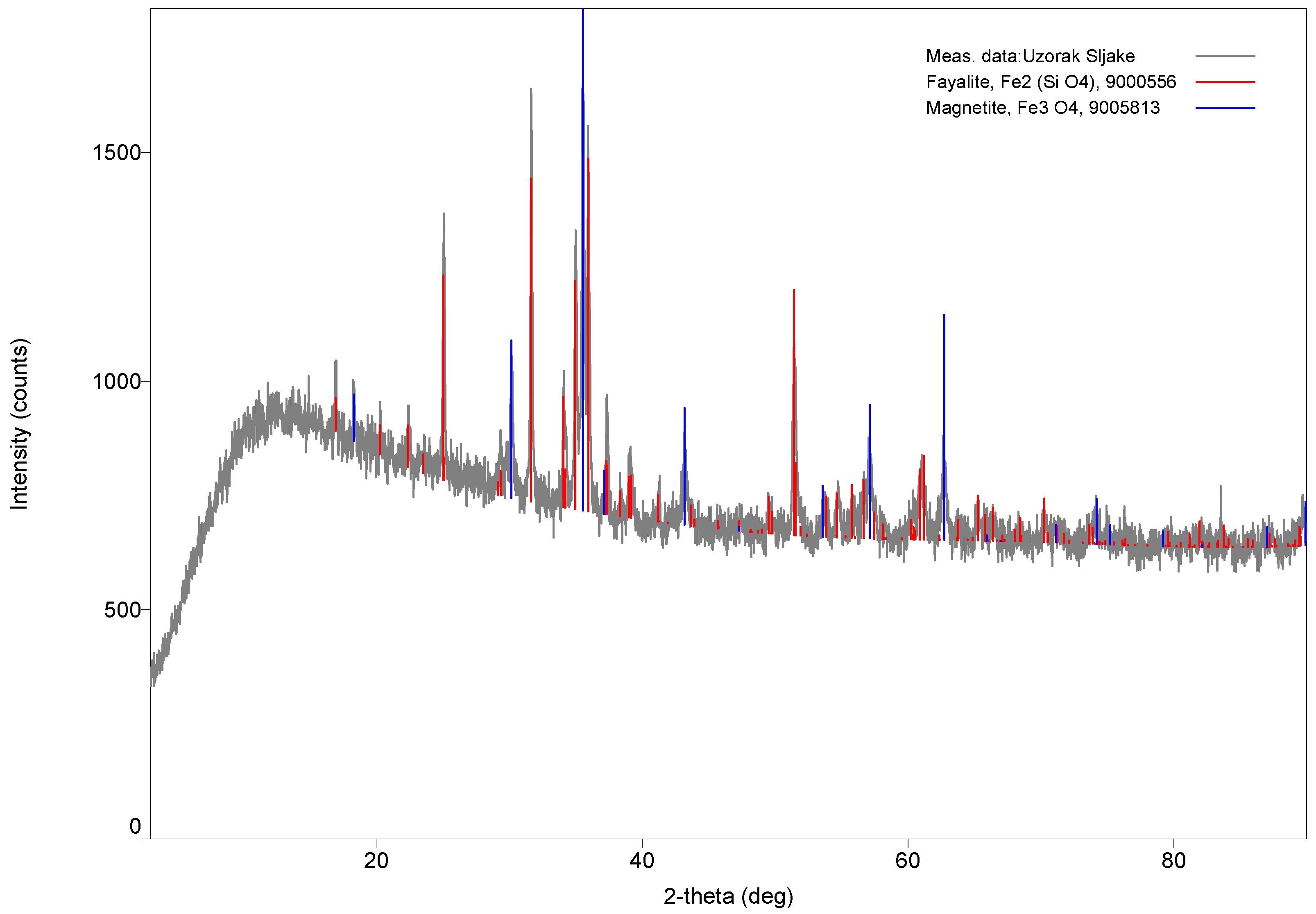

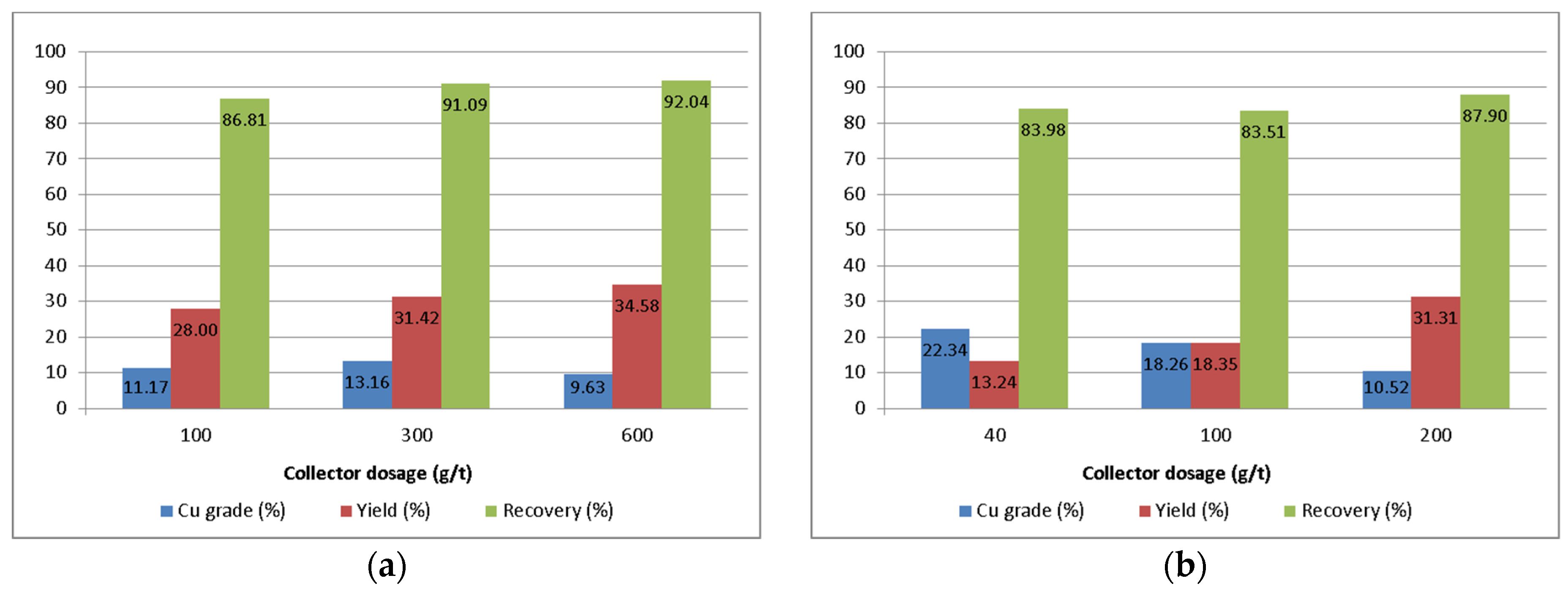
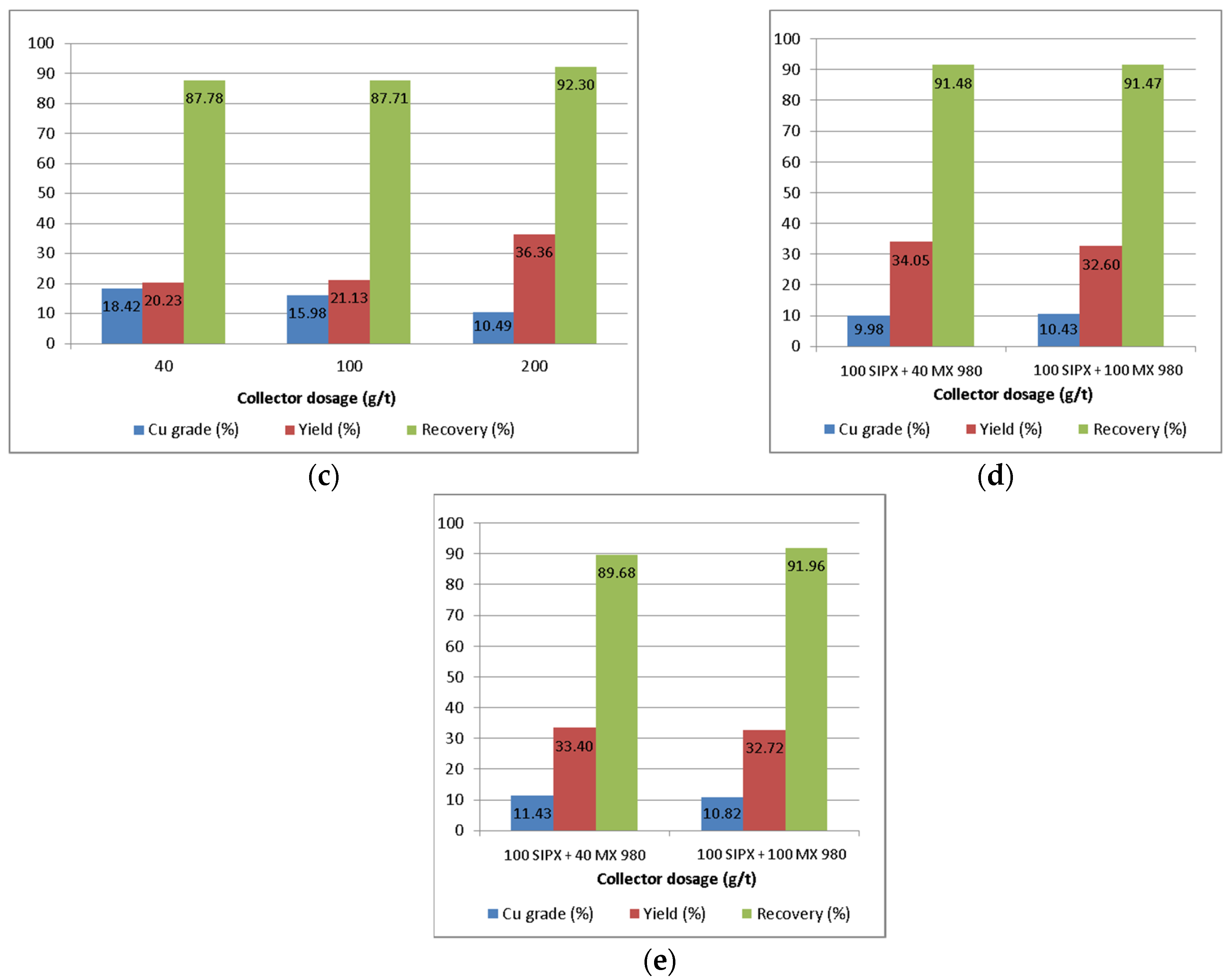
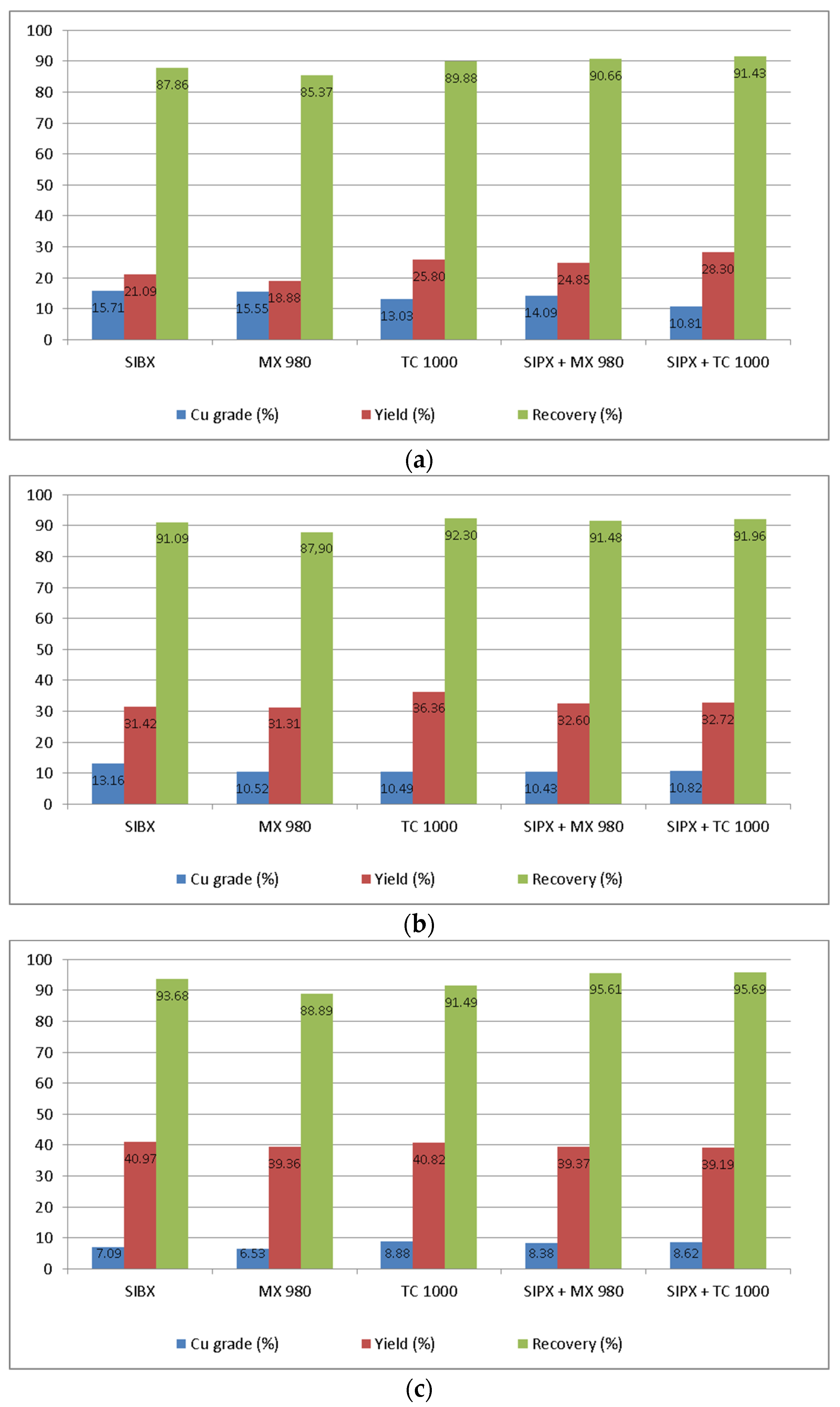
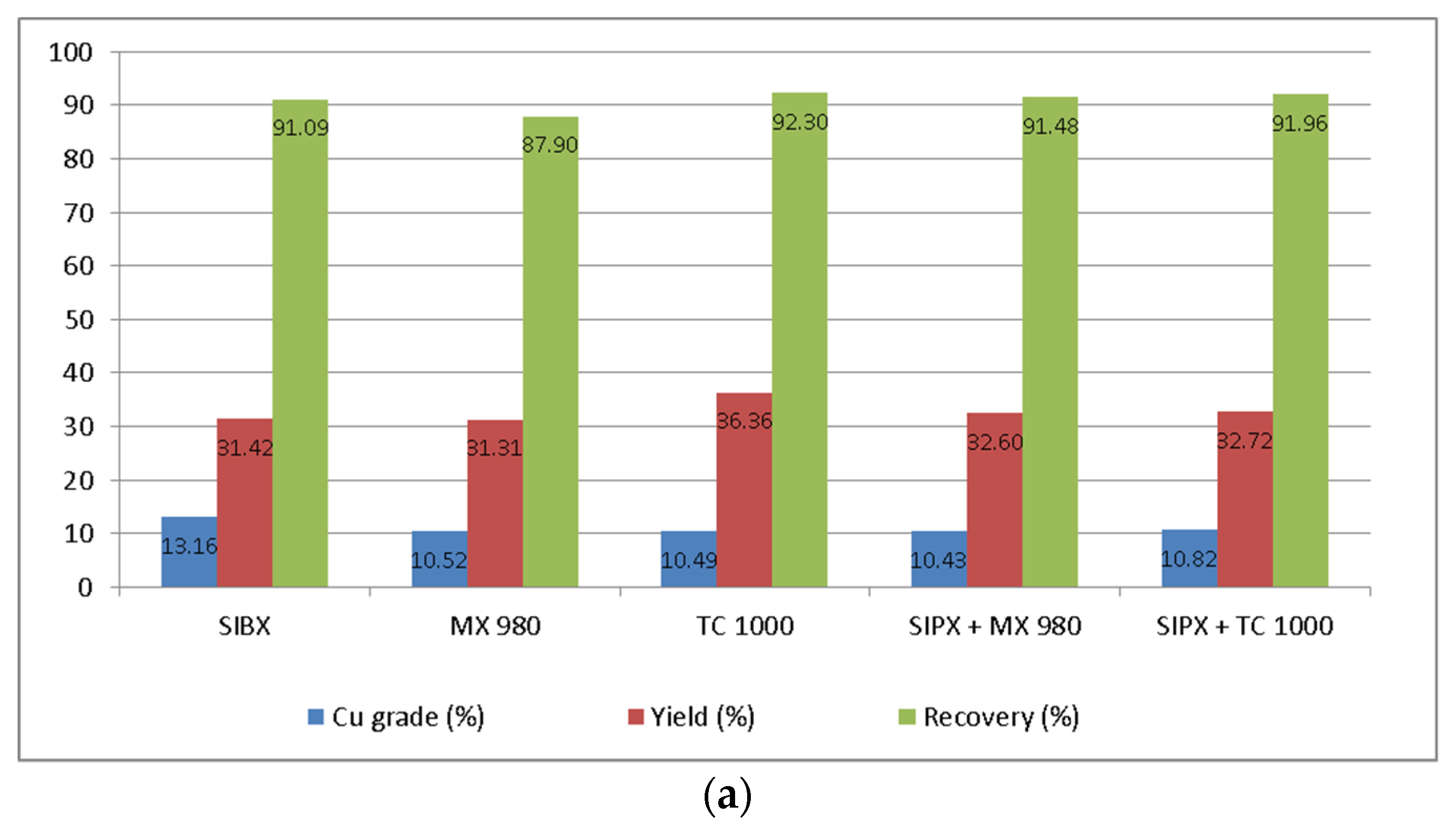
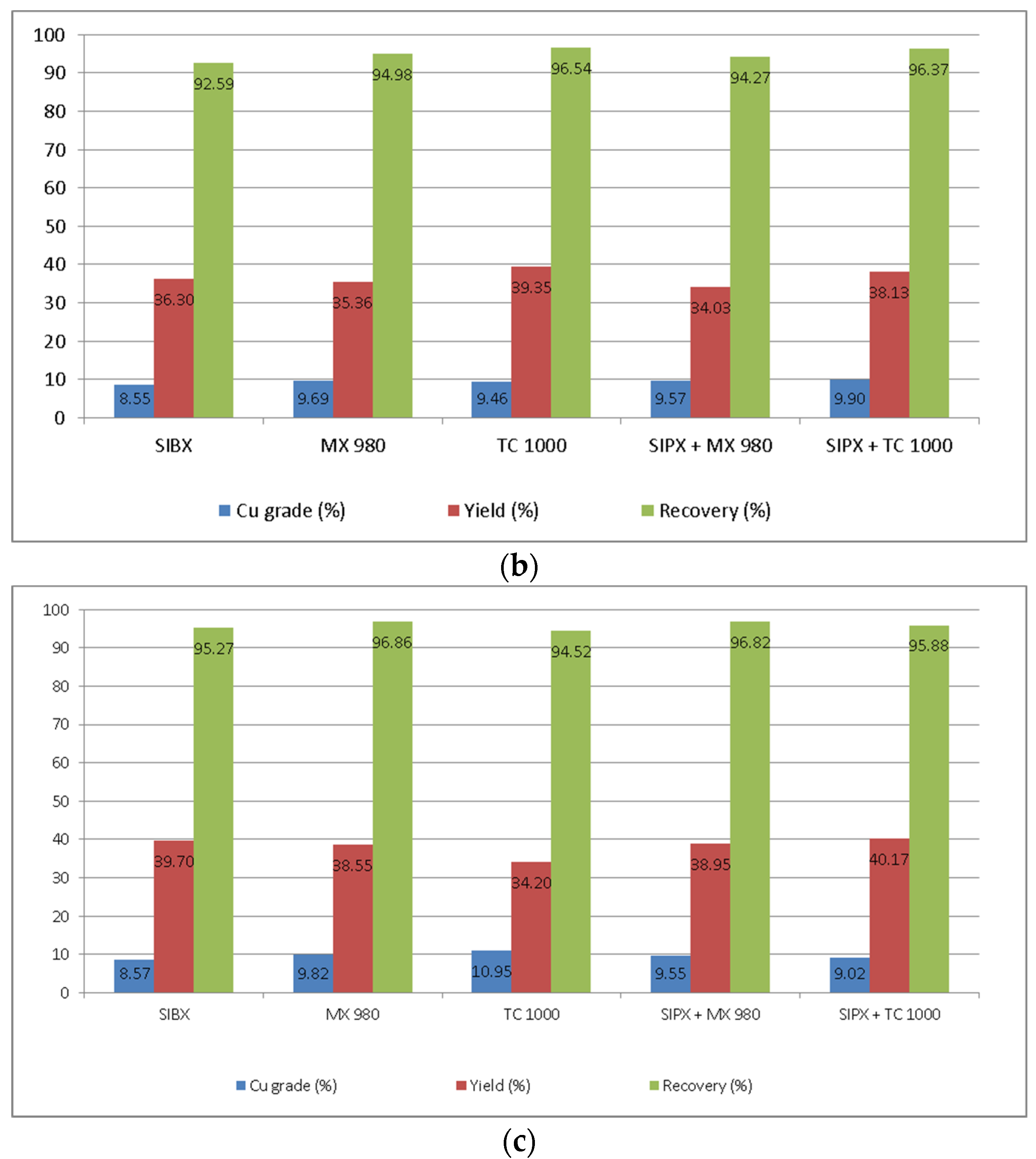
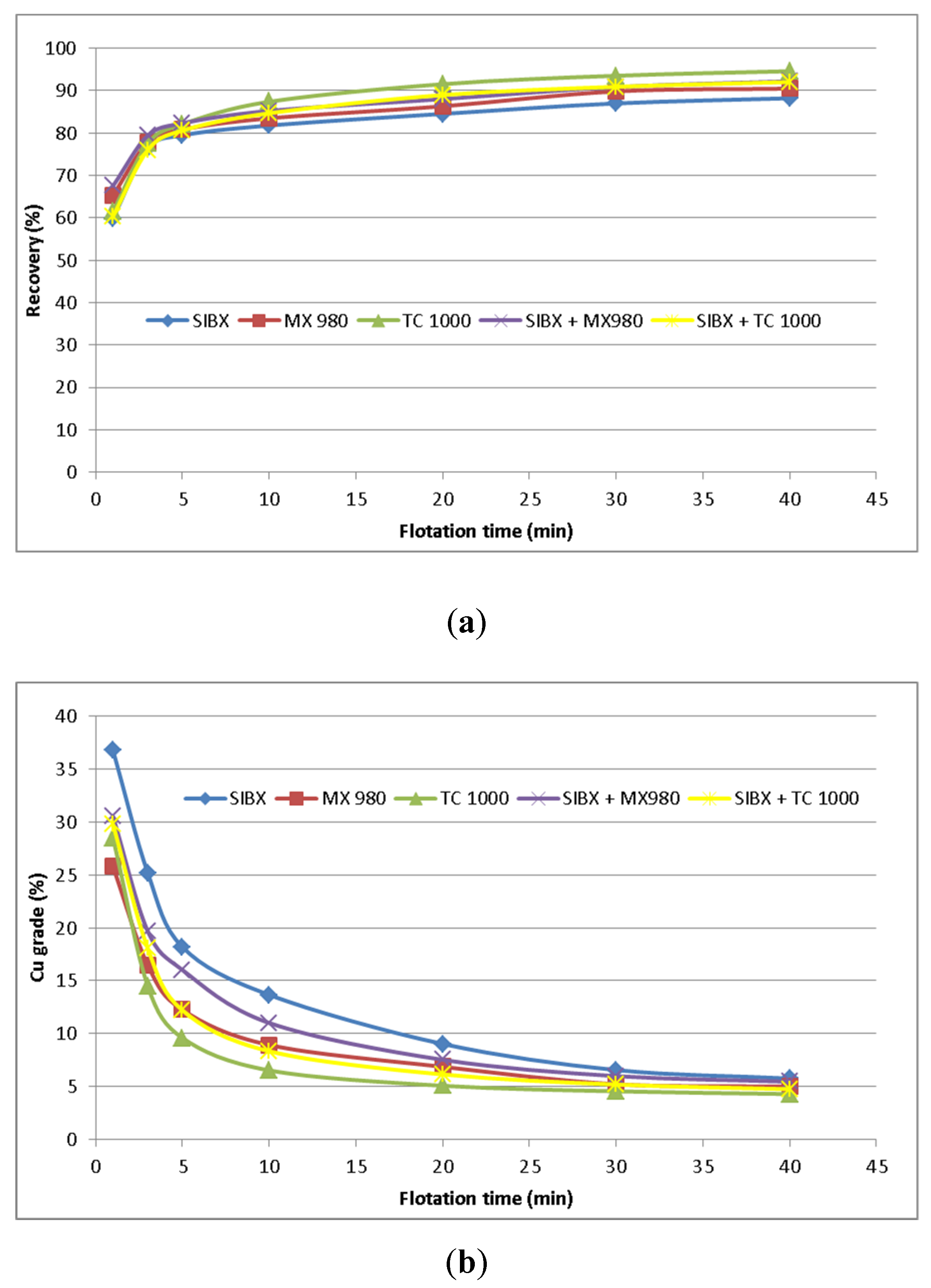
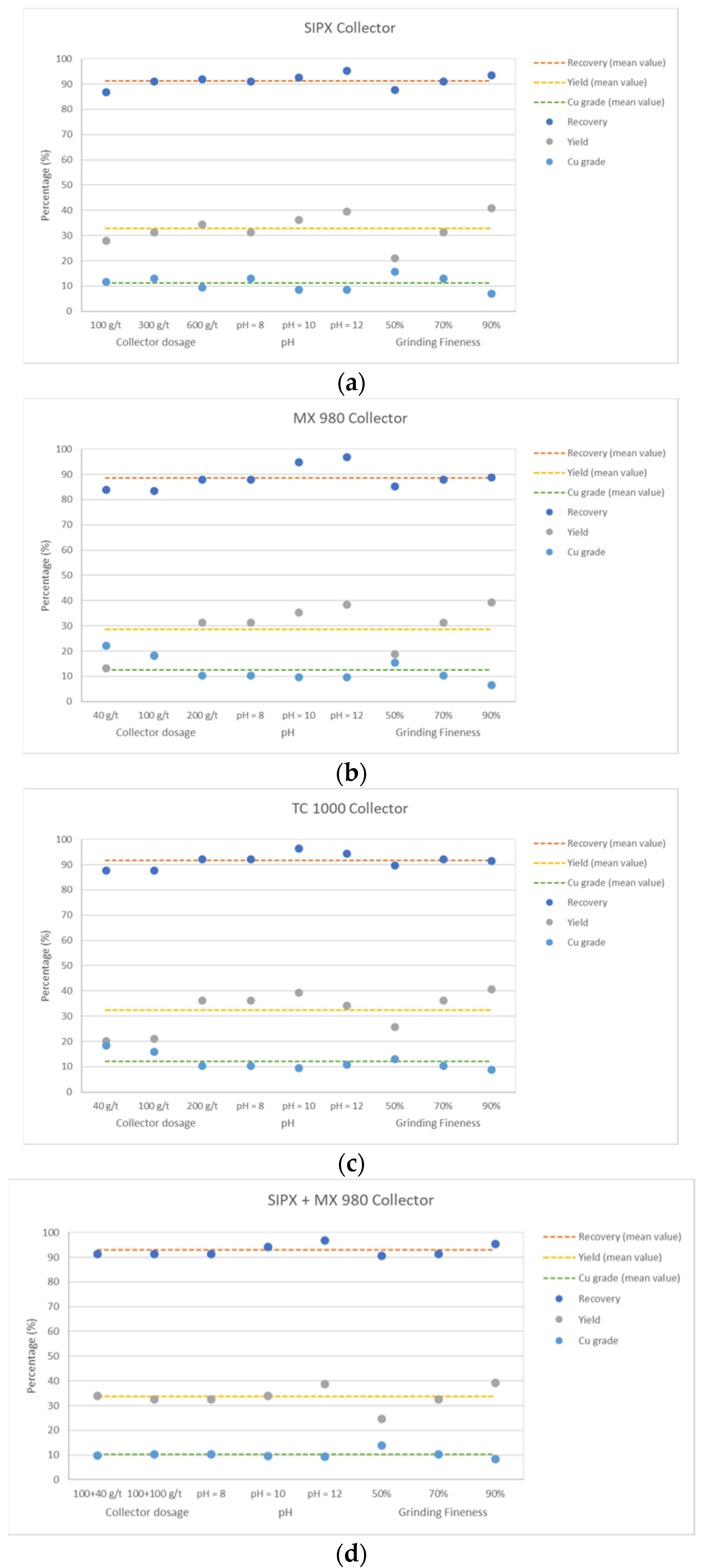
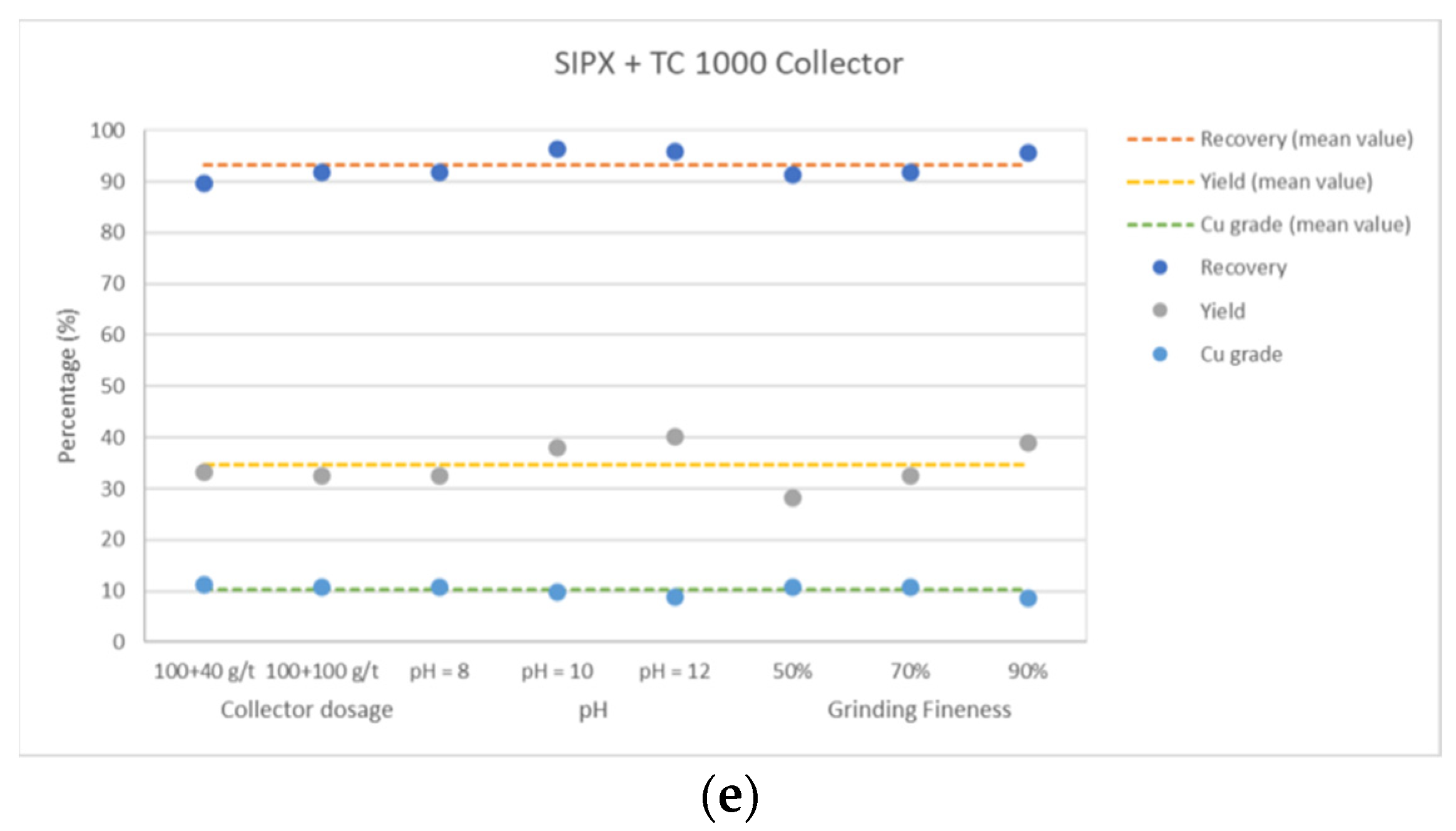
| Element/Compound | Content, (%) (g/t) |
|---|---|
| Cu | 3.56 |
| Cusulph. | 2.62 |
| Cuox | 0.94 |
| Fe | 40.63 |
| S | 1.21 |
| SiO2 | 28.34 |
| Al2O3 | 4.88 |
| Au | * 0.58 |
| Ag | * 11.30 |
Publisher’s Note: MDPI stays neutral with regard to jurisdictional claims in published maps and institutional affiliations. |
© 2022 by the authors. Licensee MDPI, Basel, Switzerland. This article is an open access article distributed under the terms and conditions of the Creative Commons Attribution (CC BY) license (https://creativecommons.org/licenses/by/4.0/).
Share and Cite
Štirbanović, Z.; Urošević, D.; Đorđević, M.; Sokolović, J.; Aksić, N.; Živadinović, N.; Milutinović, S. Application of Thionocarbamates in Copper Slag Flotation. Metals 2022, 12, 832. https://doi.org/10.3390/met12050832
Štirbanović Z, Urošević D, Đorđević M, Sokolović J, Aksić N, Živadinović N, Milutinović S. Application of Thionocarbamates in Copper Slag Flotation. Metals. 2022; 12(5):832. https://doi.org/10.3390/met12050832
Chicago/Turabian StyleŠtirbanović, Zoran, Daniela Urošević, Milica Đorđević, Jovica Sokolović, Nemanja Aksić, Novka Živadinović, and Sandra Milutinović. 2022. "Application of Thionocarbamates in Copper Slag Flotation" Metals 12, no. 5: 832. https://doi.org/10.3390/met12050832
APA StyleŠtirbanović, Z., Urošević, D., Đorđević, M., Sokolović, J., Aksić, N., Živadinović, N., & Milutinović, S. (2022). Application of Thionocarbamates in Copper Slag Flotation. Metals, 12(5), 832. https://doi.org/10.3390/met12050832







